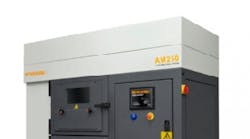RENISHAW INC. offers a new laser melting additive-metal manufacturing process it reports will produce fully dense metal parts direct from 3D CAD data using a high-powered fiber laser. Parts are built in layers, in thicknesses ranging from 20 to 100 microns, using a range of fine metal powders that are fully melted in a tightly controlled atmosphere. The new machines represent a third-generation design with features that include variable powder delivery, ultra-low oxygen content in the build atmosphere, and a safe-change filter system that minimizes user contact with materials.
Two systems are available, the AM125 and the AM250. Both models feature vacuum technology and low-gas consumption, and both adopt "machine tool" engineering in design, operation, and serviceability, emphasizing ruggedness and ease of operation. The touch-screen operator interface includes menu options for machine preparation and clean down. Consumable costs are minimized through features such as the soft re-coater blade that can be rotated several times before replacement, use of low-cost filter elements, and low gas consumption. All these reportedly improve system reliability and reduce cost of ownership.
Renishaw additive-metal systems process a variety of materials, including 316L and 17-4PH SS, H13 tool steel, aluminum Al-Si-12, titanium CP, Ti-6Al-4V and 7Nb, cobalt-chrome (ASTM75), and Inconel 718 and 625. Both systems are designed for rapid material changeover: the AM125 uses a cassette-type materials delivery system; and the AM250 uses a removable hopper, which the developer said is particularly useful for materials development or when using a range of materials. To improve system productivity, a valve interlock on the AM250 allows addition of extra powder while the process is running. Safe processing of reactive materials (e.g., titanium or aluminum) is ensured with features like a gas knife that clears away reactive, sooty emissions, and a heated build plate.
The AM125 provides a part-build volume of 125×125×125 mm (X×Y×Z). The AM250 provides a build volume of 250×250×300 mm (X×Y×Z), with Z axis extendable to 360 mm. Both have build rates of 5 to 20 cm3/hour, according to the material, part density, and part geometry. The AM125 offers a choice of 100- or 200-W laser. The AM250 has a 200- or 400-W laser.
Both designs have a fully welded vacuum chamber, so they’re capable of low-pressure evacuation followed by a recharge with high-purity argon gas. The developer said gas consumption after the initial chamber flood is very low, so it’s possible to operate at oxygen concentrations below 50 ppm – which is critical for processing reactive materials — and contirbutes significantly to material integrity and mechanical performance.
Product designs are completed off-line and the build files are delivered to the machine via a secure network or direct connection. Product traceability has been improved by the addition of process data and event logging as standard, with various additional process control options on request.
Visit www.renishaw.com.









